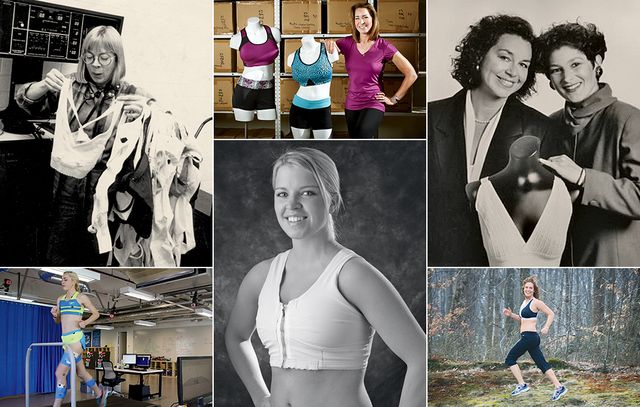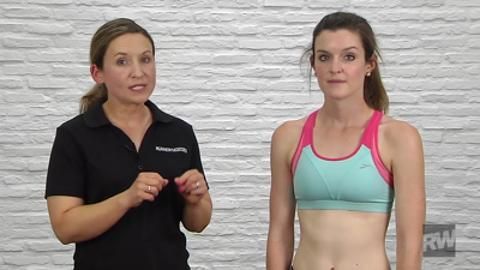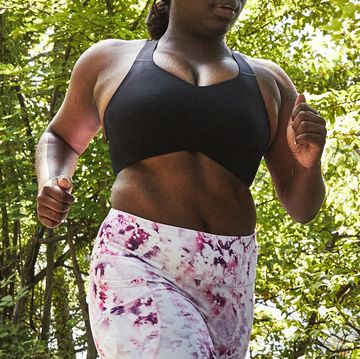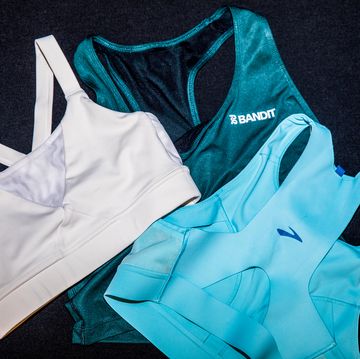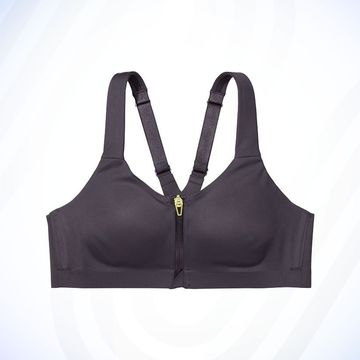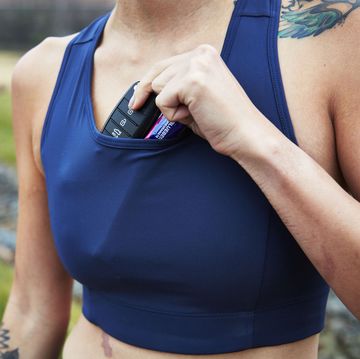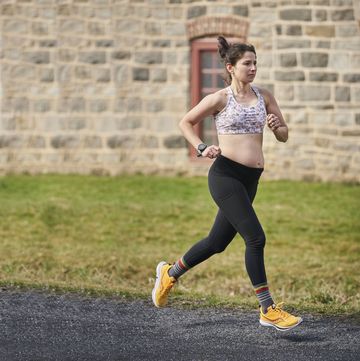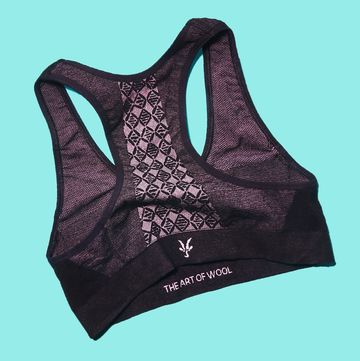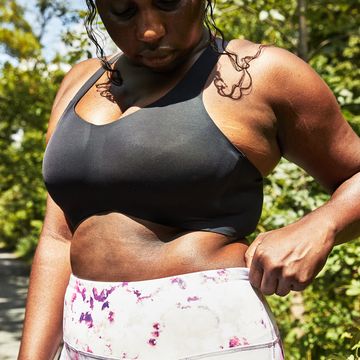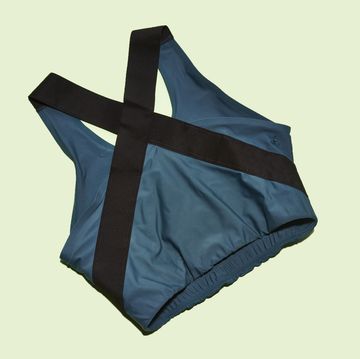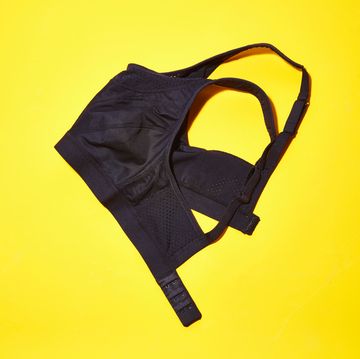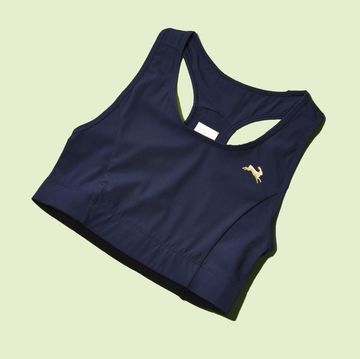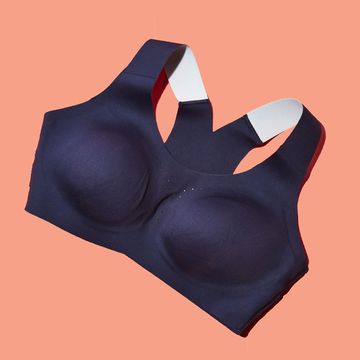Forty years ago, an ordinary runner invented what she couldn’t find in stores: a sports bra. Since then, pioneering women have continued to design better and better models, enabling females of all body types to join running’s ranks.
* * *
“Here’s your jockbra, ladies!” It sounded like the kind of catcall a woman might hear on the street. Except this was a design session where Lisa Lindahl was working with her friend Polly Smith on a supportive bra for runners, and the heckler was Lisa’s husband, strutting around wearing a jockstrap stretched across his chest. Lindahl tried the item on her chest, and a solution began to take shape.
This was the summer of 1977, during the height of both the women’s liberation movement and the first jogging craze. Yet for all the things women did in their Maidenform bras, running in comfort wasn’t one of them: Traditional lingerie let runners’ breasts bounce and whirl like Lotto balls. So Lindahl, a graduate student at the University of Vermont, was determined to create a bra that she and other women could actually run in. Lindahl’s friend Smith, who made costumes for the Champlain Shakespeare Festival, had agreed to help by stitching together a few mock-ups.
The next day, Smith sewed her own version with straps that crossed in the back (to keep them from sliding down) and a sturdy elastic band beneath the breasts for support. Lindahl tested it out while Smith’s assistant, Hinda Schreiber Miller, ran backward in front of her, watching for that dreaded bounce.
Seeing little, the trio dispatched Smith to New York City, where she bought bolts of a newfangled poly/cotton/Lycra blend that designers hadn’t yet figured out how to use. Miller hit up her parents for a $5,000 startup fund. Lindahl drafted a business plan and started hauling sample cases full of Jogbras—as the women dubbed their creation—into sporting goods stores. Thus, the sports bra was born.
“I wanted it, so I assumed every woman wanted it,” Lindahl said. She was right: Having access to a proper sports bra allowed women of all shapes and sizes to start running (and playing other sports) in unprecedented numbers. Today, sports bras are a $7 billion industry worldwide. Not surprisingly, it was mostly female athlete/inventors who got us here.
* * *
Almost without exception, the women of the first running boom were small-breasted, because they had to be: Even the famous “runner’s high” couldn’t anesthetize the pain of swirling D-cups. And although Jogbras opened the door to a whole wave of would-be runners, the stretchy pullovers didn’t deliver enough support for bigger sizes.
Renelle Braaten simply wanted to run down an errant volleyball. In the mid 1980s, the Montanan had to wear two sports bras to tame her large breasts. But she was too stubborn to quit sports—she ran track in high school, and played league volleyball after graduation—so one evening, Braaten said to her mom, “Get out your sewing kit, because we need to make me a better bra.”
Suspecting that existing sports bras were too elastic to stabilize larger breasts, she opted for less-stretchy fabrics and a full-coverage back panel to support the weight up front. It worked: Wearing her invention, Braaten enjoyed a new willingness to run after balls that careened out of bounds. “It’s amazing how you improve in your sport, once you no longer have to use your arms to hold down your boobs,” she says. She applied for a patent, and spent nine months refining the prototype. Her Enell bra hit the market in 1992, but it wasn’t until 2004—when Oprah Winfrey endorsed it on her show—that the company became a national name.
Enell’s success disproved companies’ claims that large-breasted women didn’t need or want a sports bra. But the bra itself wasn’t every woman’s holy grail: Distance runners, in particular, wished for something that felt less compressive and would allow for full, deep breaths.
RELATED: First Look: Nike’s New Flyknit Bra Offers Simple Yet Sturdy Support
Cynthia Smith was one such runner. As a 32F triathlete, she needed a supportive bra that she could swim in. So the retired attorney studied an online bra-making manual, bought a $40 sewing machine, and settled on a design that inverts the standard bra structure. Most use stretchy fabric for the cups and rigid material between the breasts, but Smith did the opposite: Lynx, the brand Smith founded in January 2011, uses strong, inelastic fabric everywhere but between the cups and across the back. “The goal was to minimize vertical movement but maximize horizontal motion, so you can breathe,” she says. Her innovation qualified for three patents.
Hilary Heath, a former marketing and sales rep for a software developer who established a sports bra company called Sturdy Girl Sports in January 2012, also patented her design. It uses a sturdy, overlapping M- and W-shaped interior structure to support large cup sizes using the same kind of pullover, hardware-free style that small-breasted women have used since the Jogbra.
“Cottage industries like Sturdy Girl are great in that they try to solve something very specific, like making cute bras for large-breasted runners,” says Heath. But big, established brands can place huge orders with factories and fabric suppliers, so they get cheaper pricing. That makes it hard for passion-driven companies like Sturdy Girl to compete.
Fortunately, major brands have begun to increase their commitment to building great sports bras. That’s due, in part, to changing norms: America’s average bra size grew from 34B in 1987 to 34DD in 2013, meaning there are more large-breasted buyers. And there’s more science to help guide development.
“In the past five years, there’s been an explosion of brands availing themselves of the research,” says LaJean Lawson, an exercise scientist who has studied breast movement for 33 years. Her landmark 1984 paper was criticized as a waste of state funds—studying bouncing breasts earned her a Golden Fleece Award, a sardonic honor given to public officials who misuse taxpayer money—but since then, sports bra manufacturers have started to see value in such data. In 1987, Jogbra (now Champion, after Playtex bought the brand in 1990) hired her as a consultant. Today, Lawson operates her own bra testing lab, and more companies have brought breast researchers into the fold: Since 2010, Brooks (which consolidated with Moving Comfort in 2006) has operated a dedicated bra testing lab staffed by biomechanists. And Lululemon sought input from Progressive Sports Technologies at Loughborough University—one of the world’s leading authorities on applying data analytics to products—for its new Enlite model to minimize breast movements that cause discomfort.
So while small, female-founded companies rely on their founders’ instincts to design effective products, larger brands—often headed by men, or by nonathletic women who don’t personally know what a sports bra ought to do—can look to science to inform design. Lawson’s lab, for example, includes 3D opto-electronic sensor technology that uses infrared light to read reflective markers on the bra: As a woman runs, the system tracks 3D coordinates of each marker’s movement so Lawson can identify body and bra movement.
Such technology is pricey—the Enlite costs two ticks shy of $100—and according to Lawson’s focus group research, most women balk at paying more than $50 for a sports bra. But if it really helps you participate more in a sport you truly love, wouldn’t that be money well spent?
* * *
We recently reviewed 15 new sports bras. Check them out and find your favorite.
